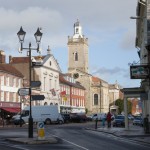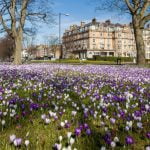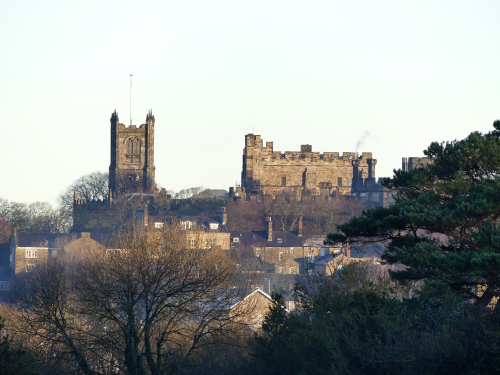
Lancaster is an ancient cathedral city and the county town of Lancashire in northwest England. Situated on the banks of the River Lune, the town lies 7 miles (km) southeast of Morecambe and 14 miles (km) south of Carnforth. Historically, the House of Lancaster was a branch of the English royal family, whilst the Duchy of Lancaster is, with Cornwall, one of only two remaining royal dukedoms in the country. At the 2011 national census, the population of the city of Lancaster was recorded as 48,085, while that of the wider urban district was 138,375.
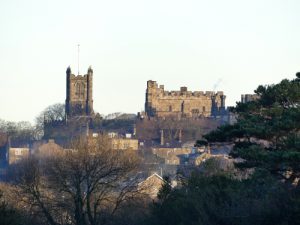
Image: Peter_Fleming/Shutterstock.com
A Fleeting History
The first known settlers of the Lancaster area were the Romans. Archaeological evidence suggests they built a temporary fort at Lancaster around 60 AD. However, the fort is thought not to have been continuously occupied until it was rebuilt in stone around 100 AD. The fort’s name remains uncertain, as it was only ever recorded in abbreviated form, but it is thought most likely to have been called Calunium. It is generally believed that the fort remained active up until the end of the Roman occupation of Britain in the early 5th century.
Almost nothing is known of Lancaster between the end of Roman rule in Britain around 410 AD and the Norman Conquest of 1066, although it seems most probable that the settlement remained occupied. Lancaster’s location on the border of both the ancient kingdoms of Mercia and Northumbria meant that its control inevitably passed back and forth between the two rules. Archaeological studies suggest there was a 7th century Saxon church at the site of St Mary’s and monastery at, or near, the site of the present-day Lancaster Priory, as early as the 8th century.
Norman Lancaster
Following the Norman invasion of 1066, according to the Domesday Book, Lancaster fell under his direct control of William the Conqueror. The document records the first known written reference to the place name of ‘Lancaster’. In 1094, a Norman priory was founded, by which time, William had granted the Manor (or Honour, as it was known) of Lancaster to Roger de Poitou. Around the same time it’s thought that the building of Lancaster Castle began at the site of the old Roman fort. The original castle was most likely a timber structure, which incorporated the earthworks of the Roman fort into its defences. Experts agree it wasn’t the traditional Norman ‘motte and bailey’ construction as no trace of a moat as ever been found. Most likely it was a ‘ringwork’ fortification, a circular defensive enclosure, relying on its structure and earthworks for protection.
In 1102, Roger de Poitou fled England after participation in a failed rebellion against the new king, Henry I. Consequently, the Honour of Lancaster, including the castle, was taken back under the care of the crown. By 1141, David I of Scotland was occupying the ‘Honour’ in a pact with King Stephen of England, in an effort to sustain the latter’s reign. It would seem probable that it was David who ordered the further fortification of the castle. In 1193, a Lancaster received a borough charter, granted by King Richard I to John, Count of Mortain, who would later become King of England, himself.
In 1362 Lancaster gained importance when it was made the seat of the assizes and the principal town in the county of Lancashire. It was the same year that John of Gaunt, third son of Henry III, became Duke of Lancaster when aged twenty-two. Although he held the title until his death in 1399, it thought he only ever visited Lancaster twice, first in 1385 and then again in 1393, staying for only a few days on each occasion. It was John of Gaunt’s son Henry Bolingbroke, the future Henry IV, who built the imposing main entrance and gatehouse to the castle, circa 1400. Henry’s estates were to become the Duchy of Lancaster, which have belonged to the Crown ever since.
The Red Rose
Early in the 15th century, the Duchy (or House) of Lancaster took up the red rose as its emblem, whilst its rival, the House of York, adopted the white rose. The rivalry between the two houses was to eventually lead to a power struggle for the throne. By 1455, the discord between the two factions erupted into a full-blown civil war. The ensuing conflict was dubbed the ‘War of the Roses’ and raged on until 1485 when Henry Tudor defeated Richard III at the Battle of Bosworth Field. He was crowned Henry VII, and in 1486, married Elizabeth of York, daughter of Edward IV, to unite and restore harmony between the two houses.
In the late 16th century, Elizabeth I recognised the strategic importance of Lancaster Castle. Following the threat of a Spanish invasion in the 1580s, she paid monies towards its re-fortification and extension. It also came in for another additional use. In a long-running spat with Rome, Elizabeth had declared that all Catholic priests were guilty of high treason. The castle was used to imprison any such priests who could be found in Lancashire – of those arrested, most were tried and executed.
In 1612, the castle also became the venue for the notorious Pendle witches trials. The twelve accused all lived in the area surrounding the nearby Pendle Hill. Whilst, one of the charged died in prison awaiting trial, of the 9 women and 2 men who faced the assizes, ten were found guilty and hanged. Only one, the fortunate Alison Grey, was found not guilty. The sentences metered out only added to the town’s notorious reputation for hanging offenders. The numbers of those hanged were only second to London and earned Lancaster the dubious title of “the Hanging Town”.
The Civil War
During the English Civil Wars of the mid-17th century, Lancaster itself did not particularly take sides, but with its castle and geographical location made it of strategic importance. In February 1643, the castle surrendered to the Parliamentarians. However, in March, the Royalists, meeting little resistance, plundered and burnt much of the town. The Parliamentary forces remained firmly in the security of the castle, but later in the war, would re-garrison the town. After the Civil Wars had ended, the castle was partially demolished so that it could never be garrisoned again. Only, the courts, prison, gatehouse and a few small outer buildings were retained.
By the late 17th century, Lancaster began to capitalise on its position on the Lune estuary and west coast of England. The growth of the British colonies in North America and the West Indies and the potential for trade saw Lancaster become a port town. The town’s Port Commission was established in 1749 to improve the facilities of St George’s Quay. And, in 1764, the Old Customs House was built. The town’s chief imports were sugar, rum, cotton and mahogany, whilst exports included textiles and ironmongery. Lancaster’s leading industries included the production of furniture, candles, sailcloth and rope, and by the end of the century, shipbuilding.
The end of the 18th century saw Lancaster’s growing prosperity bring fine houses and amenities to the town. The Grand Theatre was built in 1781, and two years later, the Town Hall. In 1792, the Lancaster to Preston canal opened, and five years after, the Lune Aqueduct was built. In 1801, the time of the first national census, Lancaster’s population was recorded as a little over 6,000. However, not everything was going Lancaster’s way, since it was at this time that the town’s port went into dramatic decline. The River Lune had begun to silt up and Lancaster’s river port facilities could not compete with those at the nearby and rapidly expanding Liverpool Docks.
19th Century Lancaster
Despite the town’s loss of port status, Lancaster experienced dramatic growth during the 19th century. The early 1800s saw the cotton trade established in the town. In 1825, gas street lighting was introduced, and in 1840, the railway came when the terminus station of the Carlisle and Lancaster Railway was built. In the mid-1800s factories producing oilcloth and linoleum were established. In 1853, the town got its first piped water supply, with the White Cross militia barracks opening a year later. In 1859, St Peters Roman Catholic Church was built, and in 1860, a branch rail line to Morecambe opened. In 1892, electric street lighting came to the town, and, in 1896, Lancaster Infirmary opened. In 1871, Lancaster’s population had stood at 9,713 but the end of the century saw it rise dramatically to more than 25,000.
In 1904, work began on the Ashton Memorial located in Williamson Park. It was completed in 1909, being dubbed “England’s grandest monument”. Between 1916 and 1918 Lancaster jail was used to house German POW’s, but closed as a prison after WWI. In 1937, Lancaster was finally awarded city status. In 1954, Lancaster Castle was returned to prison use for low-priority criminals. In 1965, work began on the construction of Lancaster University, which opened its doors to students in 1968.
Modern Lancaster
In 1999, Queen Elizabeth II visited Lancaster to mark the 600th anniversary of the Crown’s ownership of the duchy.
Local Economy
Today, Lancaster’s economy is primarily based on the service industry but it does retain a few of its historical industries, such as furniture and linoleum manufacture. Newer industries include the likes of animal feed, textiles, chemicals, paper, synthetic fibres, mineral fibres and farm machinery. The city also remains a major market centre and as one of the largest livestock markets in northwest England. The city is also very much viewed as a regional centre for North Lancashire. In recent times, with a view to attracting more tourism, the authorities have introduced a busy programme of events and festivals to the city.
Festivals
Lancaster’s calendar of events kicks off with the Food Festival held during the May Bank holiday at Lancaster Leisure Park. Dino Day also takes place on Spring Bank Holiday celebrating Lancaster’s historic link with the dinosaur through its famed son, Sir Richard Owen. The Down by the Riverside Festival is a music event set on the banks of the River Wyre about 4 miles south of Lancaster. As well as music, you’ll find outdoor theatre, craft ales, plenty of food, funfairs, and other activities, also taking place on the Spring Bank Holiday. Early September sees the Lancaster Festa Italia take place in a celebration of all things Italian. The Highest Point Festival is s 2-day music event that takes place in mid-September at Williamson Park. Lancaster Jazz Festival also takes place over 5 days in September. The Lancaster Music Festival takes place in October with performances at more than 50 venues. Early November sees the two-day Light Up Lancaster Festival, which culminates in one of the biggest fireworks displays in the northwest. Chinese New Year celebrations are held in the city centre in either late January or early February.
Twinning
Lancaster is twinned with seven towns across Europe, which are; Rendsburg (Germany), Perpignan (France), Viana do Castelo (Portugal), Aalborg (Denmark), Almere (Netherlands), Lublin (Poland) and Växjö (Sweden).
Getting To Lancaster!
By Road
It couldn’t be easier to get to Lancaster by road as it lies just off the M6, the country’s arterial North-South route. Leave the M6 at Junction 33 and take the A6 into Lancaster, which is less than 2 miles away.
By Train
Lancaster is a stop on the West Coast mainline between London and Scotland, thus there are direct rail links to the city from many of the UK’s major cities and airports.
By Bus
Megabus and National Express offer a late evening direct service from London Victoria to Lancaster, with the 210-mile journey taking about 6 hours. There is also direct coach travel to Lancaster from many of the UK’s major towns and cities.
By Air
The nearest airport to Lancaster is the domestic Blackpool Airport, which is about 21 miles (34 km) away. However, the nearest international airports are Liverpool and Manchester which are 49 miles (79 km) and 53 miles (85 km) away, respectively.
Lancaster City FC
Lancaster City Football Club is a semi-professional team that currently plays in the Northern Premier League Premier Division, the seventh tier of English football. The official team nickname is ‘The Dolly Blues’ which is often shortened to ‘The Dollies’. They play their home games at the ‘Giant Axe’, a stadium with a capacity of around 3,500.
Notable People
A few notable people who were born in Lancaster are;
- Sir John Ambrose Fleming FRS (1849 – 1945) – was an electrical engineer and physicist who invented the vacuum tube and the radio transmitter, which made the first transatlantic radio transmission. He was born in Lancaster and attended the Lancaster Royal Grammar School before attending university.
- John Waite – is a rock musician, singer and songwriter of some longevity, arguably best known (in the UK) for his 1984 hit single “Missing You”. Whilst mostly pursuing a solo career he also enjoyed moderate success as the lead singer with ‘The Babys’ and ‘Bad English’. Born in Lancaster in 1952, he was educated at Greaves Secondary Modern and Lancaster Art College.
- Jon Richardson – is a well-known comedian, TV personality and presenter. Born in Lancaster in 1982, he attended Lancaster Royal Grammar School.
- Sir Richard Owen (1804 – 1892) – was an eminent biologist, anatomist, naturalist and palaeontologist. One of the founders of London’s Natural History Museum, he is credited with coining the word ‘Dinosaur’. He was born and grew up in Lancaster.
Did you know?
- Up until 2011 Lancaster Castle was the oldest working prison in the UK. Other than its closure as a prison between the end of WWI and the mid-1950s it continuously held prisoners for the 800 years plus from its opening in about 1200 to its closure in 2011.
- In 1660, George Fox, the founder of the Religious Society of Friends, better known as the Quakers, was sentenced to 2 years in Lancaster Castle jail for his religious beliefs. He was jailed on numerous occasions throughout his life where the charges were usually nothing more than causing a disturbance or travelling without a pass.
Things to see and do!
Some of the recommended things to see and do in and around Lancaster are:
- Lancaster Castle – is owned by the crown through the Duchy of Lancaster. The Castle has a wealth of history and only fully opened to the public in 2013. There are various organised tours and events, as well as a cafe and gift shop on the grounds.
- Williamson Park – is set in 54 acres of park and woodland with walks, play areas and great views over Morecambe Bay. It also features a cafe and shop, a butterfly house, a reptile house and a number of enclosures with small mammals.
- Ashton Memorial – is a Grade I listed ‘folly’, built by industrialist Lord Aston in the early 1900s in memory of his wife. It’s located in Williamson Park
- Lancaster Canal – was built in the late 18th century, carrying freight between Kendal and Preston. The restored towpath stretches over 27 miles and makes for a great country walk. It features the Lune Aqueduct as well as abundant wildlife.
- Lancaster City Museum – traces the city’s past from Romans times to the present day. For those interest in military history there’s also a separate King’s Own Royal Regiment Museum but housed in the same complex.
- Lancaster Canal Boats – operate year-round cruises along the scenic Lancaster Canal. During peak season (May to October) its possible to find timetabled daily cruises running from a number of locations.
- The Charter Market – is a traditional street market held in the historic Dalton Square. The market is held every Wednesday and Saturday from 9 am – 4 pm-ish. Vendors sell the usual street market fare, which includes local food produce, handicraft, flowers and plants, books, mobile phones and accessories, ceramics, pet foods, etc.
- Salt Ayre Leisure Centre – offers a wide range of activities, including swimming, indoor climbing, gym, sauna, exercise classes and badminton. It also has a kid’s soft play area. It’s located on the A589 about 3 miles out of Morecambe towards Lancaster.
- Hest Bank Cycle Route – is a circular almost-flat scenic cycleway some 20 miles in length that starts/ends at the Lune Millenium Bridge in Lancaster. Morecambe Promenade makes up part of the mostly traffic-free route.
- Lancaster Maritime Museum – is housed in the former Custom House, a Grade II listed building, located on St Georges Quay. It displays several ship models and has exhibits on the Lancaster Canal, the local fishing industry, local port development and the social/natural history of Morecambe Bay.
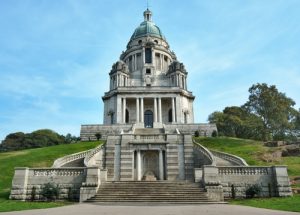
The Ashton Memorial – located in Williamson Park Image: Philip Birtwistle/Shutterstock.com
Where to stay?
There’s plenty of choice of accommodation in and around Lancaster. Morecambe is only a few miles away and provides an alternative to staying in Lancaster. You’ll find Hotels, B&Bs, Inns, Lodges, Guesthouses all in or close to the town. A broad price guide for 2 adults sharing per night is:
B&Bs/Inns/Guesthouses/Lodges/Small Hotels: £60 – 100
3/4 Star Hotel: £100 – 150
5 Star Hotel: £150+
Thinking of moving?
Thinking of moving to Lancaster? The average selling price for all property in Lancaster for the year up to August 2020 was approximately £166,100. This represents a rise of around 9% on the previous 12 months. In terms of property types, flats sold for £111,500, terraced houses for £137,800 and semi-detached for £178,200.
Thanks for joining us on our Five Minute Overview of Lancaster. Before you go why not try some of our other quizzes or have a look at some of our other location guides. better still why not join our growing community it’s free and could be very rewarding going forward.

